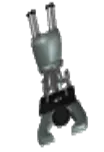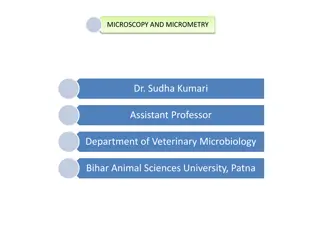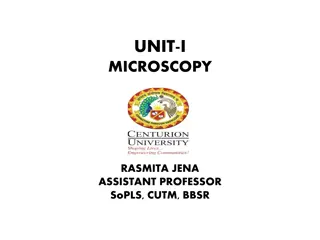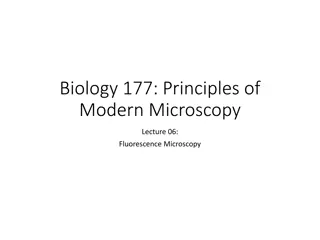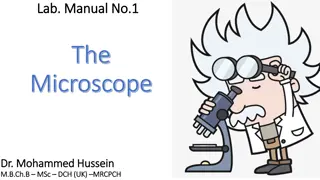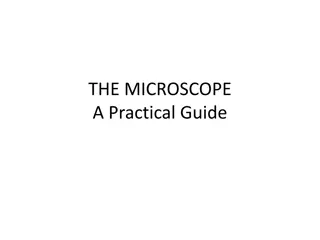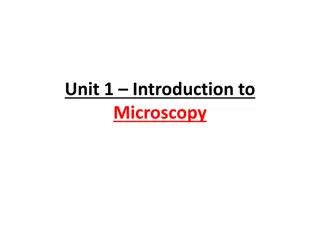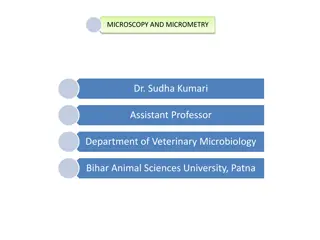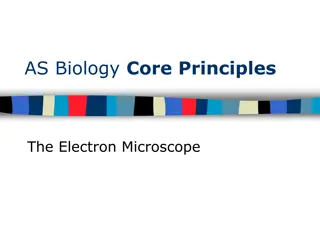Introduction to Light Microscopy: Structure, Function, and Operation
Light microscopy is a vital instrument used for studying small organisms or particles invisible to the naked eye. This lab exercise delves into the history, types, components, and operation of light microscopes, focusing on human cheek cells and onion cells. Explore the magnification and resolution powers of a light microscope and understand its mechanical and optical systems for optimal usage.
Download Presentation

Please find below an Image/Link to download the presentation.
The content on the website is provided AS IS for your information and personal use only. It may not be sold, licensed, or shared on other websites without obtaining consent from the author. Download presentation by click this link. If you encounter any issues during the download, it is possible that the publisher has removed the file from their server.
E N D
Presentation Transcript
Lab Exercise # 1 Zoo- 145 Microscopy OBJECTIVE: STRUCTURE, FUNCTION AND OPERATION OF LIGHT MICROSCOPE (Human Cheek Cells and Onion cells)
Lab Exercise # 1 Zoo- 145 INTRODUCTION The Microscope (Micron = small, scope= application) is an instrument that is generally used to study the very small organisms or particles which are not visible by naked eyes. In 1674, Anton Van Leeuwenhoeck made the microscope for the first time. This microscope has practically been made with the combination of two lenses so it is also termed as Compound Microscope.
Lab Exercise # 1 Zoo- 145 It has a provision of using the source of light thus sometimes it is also named as Light Microscope The naked human eyes have an ability to see smallest object of 0.1 mm only, while the invention of microscope made it possible to see much smaller object i.e 0.2 m or 200 nm. This characteristic of seeing the minimum distance of 200 nm between the two particles is called as Resolution Power. The microscope enlarges the view image of an object up to 1000 times of its original size and the times of enlargement is called as Magnification Power.
Lab Exercise # 1 Zoo- 145 Types of Microscope Light Microscope Electron Microscope (Electron beam is used in place of lens to magnify the image) Simple Microscope Compound Microscope (single lens) (2 sets of lenses) Monocular (With one eye piece) (With two eye pieces) Binocular
Lab Exercise # 1 Zoo- 145 The Light Microscope In the basic light microscope, the object to be magnified is placed under the lower lens (objective lens) and the magnified image is viewed through the upper lens (eyepiece lens). The microscope is composed of a mechanical system which supports the microscope, and an optical system which illuminates the object under investigation and passes light through a series of lens to form an image of the specimen.
Lab Exercise # 1 Zoo- 145 The Light Microscope The Mechanical System Base: the support. Arm: the C-shaped upright structure. Stage: the plate on which the specimens are placed. Body Tube: the hollow tube on which the objectives and eyepiece lenses are mounted. Coarse Adjustment: the knob used to focus the microscope lenses by moving the body tube. Fine Adjustment: the knob also used to focus the lenses by moving the body tube, but by a much smaller magnitude.
Lab Exercise # 1 Zoo- 145 The Light Microscope The Optical System Illuminator: artificial light, usually supplied by a light bulb, to illuminate the specimen. Condenser: lens system under the microscope stage that focuses light onto the specimen. Objective Lens: the lens closest to the specimen; usually several objectives are mounted on a revolving nosepiece. Eyepiece or Ocular Lens: the lens closest to the eye. Monocular: a microscope having only one eyepiece Binocular: a microscope having two eyepieces.
Lab Exercise # 1 Zoo- 145 How Light Microscopes Work First, the objective lens gathers light from the specimen and magnifies the image Most microscopes have several objective lenses that can be rotated into position to provide different levels of magnification (4X, 10X, 40X, 60X and 100X) The ocular lens in the eyepiece magnifies and transmits the image to your eye The magnification of the ocular lens is 10X The passage of light through two lenses forms the virtual image of the object seen by the eye.
Lab Exercise # 1 Zoo- 145 Magnification Power Magnification of the Microscope is the product of the power of eye Pieces and the Power of objective To find the total magnification of the microscope you are using, multiply the magnification of the objective lens by the magnification of the ocular lens. Magnification = Power of the eye piece X Power of objective For example: 40X (objective lens) x 10X (ocular lens) = 400X magnification
Lab Exercise # 1 Zoo- 145 The Parts of a Light Microscope Eyepiece BodyTube RevolvingNosepiece Arm ObjectiveLens Stage Stage Clips Diaphragm CoarseFocus FineFocus Light Base
Lab Exercise # 1 Zoo- 145 The Parts of a Light Microscope Light source: Could be a mirror, but most likely it is a bulb built into the base Diaphragm: Adjusts the amount of light striking an object Objective lens: Gathers light and magnifies image Ocular lens (eyepiece): Magnifies objects and focuses light to your eye Stage: Holds slide Can be moved using the coarse or fine adjustment knobs to bring the object into focus Stage clips: Hold slide in place Base and arm: Structural support for the microscope
Lab Exercise # 1 Zoo- 145 Can you name the parts? Ocular lens (eyepiece) Arm Objective Lenses Stage clip Stage Course adjustment Diaphragm Fine adjustment Light Source Base
Lab Exercise # 1 Zoo- 145 Microscope Use and Care Always carry with 2 hands Only use lens paper for cleaning Do not force knobs Always Keep covered Keep objects clear of desk and cords Place the Slide on the Microscope Use Stage Clips Click Nosepiece to the lowest (shortest) setting Look into the Eyepiece Use the Coarse Focus Follow steps to focus using low power Then use the objective of higher magnification and use fine adjustment to focus it
Lab Exercise # 1 Zoo- 145 For practice, Prepare a slide of epithelial cells of onion and stain it with Lugols iodine Observe the cells under different magnification Draw sketches and compare those with the figure shown below Simple Columnar Epithelium (Onion Cells)
Lab Exercise # 1 Zoo- 145 For practice, Prepare a slide of Human Cheek cells and stain it with methylene blue Observe the cells under different magnification Draw sketches and compare those with the figure shown below Simple Squamous Epithelium (Human Cheek Cells)


